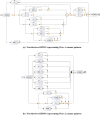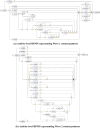Comparing Care Pathways Between COVID-19 Pandemic Waves Using Electronic Health Records: A Process Mining Case Study
- PMID: 39897098
- PMCID: PMC11782707
- DOI: 10.1007/s41666-024-00181-6
Comparing Care Pathways Between COVID-19 Pandemic Waves Using Electronic Health Records: A Process Mining Case Study
Abstract
The COVID-19 pandemic caused rapid shifts in the workflow of many health services, but evidence of how this affected multidisciplinary care settings is limited. In this data study, we propose a process mining approach that utilises timestamped data from electronic health records to compare care provider patterns across pandemic waves. To investigate healthcare patterns during the pandemic, we collected routine events from Scottish hospital episodes in adults with COVID-19 status, generating treatment logs based on care provider input. Conformance checking metrics were used to select the Inductive Miner infrequent (IMi) algorithm for downstream analysis. Visual diagrams from the discovered Petri Nets indicated interactions on provider- and activity-level data subsets. Measures of "cross-log conformance checking" and graph edit distance (GED) further quantified variation in care complexity in adverse subgroups. Our baseline cohort included 1153 patients with COVID-19 linked to 55,212 relevant care provider events. At the conformance checking stage, the IMi model achieved good log fitness ( ) and generalisation ( ), but limited precision ( ) across all granularity levels. More structured care procedures were present in Wave 1, compared to limited multidisciplinary involvement in Wave 2. Care activities differed in patients with extended stay ( vs in shorter stays). We demonstrated that process mining can be incorporated to investigate differential complexity in patients with COVID-19 and derive fine-grained evidence on shifts in healthcare practice. Future process-driven studies could use clinical oversight to understand operational adherence and driving factors behind service changes during pressured periods.
Supplementary information: The online version contains supplementary material available at 10.1007/s41666-024-00181-6.
Keywords: COVID-19; Care pathways; Conformance checking; Electronic health records; Health services; Process mining.
© The Author(s) 2024.
Conflict of interest statement
Conflict of InterestThe authors declare no competing interests.
Figures






Similar articles
-
A novel trace-based sampling method for conformance checking.PeerJ Comput Sci. 2024 Dec 18;10:e2601. doi: 10.7717/peerj-cs.2601. eCollection 2024. PeerJ Comput Sci. 2024. PMID: 39896400 Free PMC article.
-
Automatic Process Comparison for Subpopulations: Application in Cancer Care.Int J Environ Res Public Health. 2020 Aug 7;17(16):5707. doi: 10.3390/ijerph17165707. Int J Environ Res Public Health. 2020. PMID: 32784617 Free PMC article.
-
Signal from the noise: A mixed graphical and quantitative process mining approach to evaluate care pathways applied to emergency stroke care.J Biomed Inform. 2022 Mar;127:104004. doi: 10.1016/j.jbi.2022.104004. Epub 2022 Jan 25. J Biomed Inform. 2022. PMID: 35085813 Free PMC article.
-
Process Mining in Primary Care: A Literature Review.Stud Health Technol Inform. 2018;247:376-380. Stud Health Technol Inform. 2018. PMID: 29677986 Review.
-
Adult patient access to electronic health records.Cochrane Database Syst Rev. 2021 Feb 26;2(2):CD012707. doi: 10.1002/14651858.CD012707.pub2. Cochrane Database Syst Rev. 2021. PMID: 33634854 Free PMC article.
Cited by
-
Odor classification: Exploring feature performance and imbalanced data learning techniques.PLoS One. 2025 May 28;20(5):e0322514. doi: 10.1371/journal.pone.0322514. eCollection 2025. PLoS One. 2025. PMID: 40435193 Free PMC article.
References
-
- Weblin J, Harriman A, Butler K, Snelson C, McWilliams D (2023) Comparing rehabilitation outcomes for patients admitted to the intensive care unit with COVID-19 requiring mechanical ventilation during the first two waves of the pandemic: a service evaluation. Intensive Crit Care Nurs 75:103370. 10.1016/j.iccn.2022.103370 - PMC - PubMed
LinkOut - more resources
Full Text Sources
Research Materials
